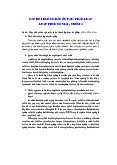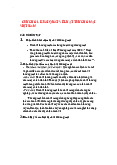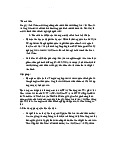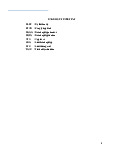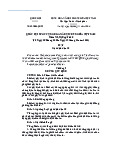


















Preview text:
lOMoAR cPSD| 46884348 lOMoAR cPSD| 46884348 CHAPTER TWO. LAW OF THE WTO
CHAPTER TWO. LAW OF THE WTO 57 lOMoAR cPSD| 46884348 LAW OF THE WTO
SECTION ONE. INTRODUCTION
The World Trade Organization (WTO) is one of the most important
international institutions of the contemporary world. Although it is a
fairly young organization, officially beginning its existence only on 1
January 1995, the original trading system of the WTO is almost a half a
century older than the organization itself. To understand the WTO, it is
necessary to know about its history, particularly the GATT 1947, which
remains the bedrock of the world trading system. This Section reviews
the evolution of the WTO and cursorily looks at the institutional aspects of the WTO.
1. HISTORICAL ANTECEDENTS
The origins of the WTO date back to the concluding years of World War
II, thus in the context of post-war planning negotiations. There was then
a strong desire among the post-war planners, led by Churchill (the United
Kingdom’s Prime Minister) and Roosevelt (the United States’ President),
to avoid repeating the political and economic disaster partly caused by
protectionism between World War I and World War II.1 Besides the
economic rationale explained in Chapter One, the basic assumptions,
which have ever since constituted the essential premises for the law of
international trade, are clear: it was necessary to encourage cross-border
trade by limiting government interference with the movement of goods,
conducted primarily by private companies. Upon these assumptions, the
discussions between officials from the United Kingdom (hereinafter the
‘UK’) and United States (hereinafter the ‘US’) on trade commenced from
1943 and culminated in the so-called ‘Proposals for Expansion of World
Trade and Employment’ in late 1945 (hereinafter the ‘Proposals’).2 The
Proposals envisaged a code of conduct relating to government
restrictions on international trade and the creation of an International
Trade Organization (hereinafter the ‘ITO’) to administer the code. 1
This came along with the abandonment of isolationism by the US in favour of leadership role in world affairs. 2
The document was released at a Press Conference of the US Department of State on 6
December 1945. Reproduced in (1945) 13 US Department of State Bulletin, at 912-929.
Before being publicly disclosed, the Proposals were transmitted to the governments of a number of countries. 58
TEXTBOOK ON INTERNATIONAL TRADE AND BUSINESS LAW lOMoAR cPSD| 46884348
In early December 1945, after the public release of the Proposals,
the US invited fifteen states to a negotiation on tariff reductions. Every
invited country, except the Soviet Union, had accepted the invitation by
January 1946 although the talks did not take place until early 1947.3
The US also pursued a second track within the framework of the United
Nations, also established in 1945. In its first meeting in February 1946,
the Economic and Social Council of the United Nations, at the proposal
of the US, adopted a resolution calling for an International Conference on
Trade and Employment and appointed a Preparatory Committee to draft a
document to be considered at such a conference. The goal of this
Conference was not to negotiate tariff reductions; rather, it was to prepare
a much broader charter for an International Trade Organization (‘ITO’).
The US had by that time drafted a Suggested Charter,4 a revision of
the 1945 Proposals, as the basis for the ITO Charter negotiations.
Altogether four meetings were held to negotiate the ITO Charter.
The meeting of the Preparatory Committee took place in London in
October-November 1946 and produced a first draft of a Charter for the
ITO which was revised after a second technical drafting committee
meeting held briefly at Lake Success, New York, in early 1947. A third
and principal preparatory meeting was held in Geneva from April to
October 1947 and was followed by the Plenary Conference on Trade and
Development convened by the United Nations in Havana from
November 1947 to March 1948 to complete the ITO Charter. Yet, the
ITO never entered into force, the principal reason being the lack of
support from the US Congress. That the US, the world’s leading
economy and trading nation, would not be a member of the ITO
dissuaded other countries from the establishment of the ITO.
While the ITO was a stillborn, its most important trade liberalising
instrument, i.e., the General Agreement on Tariff and Trade (hereinafter the
‘GATT 1947’), survived. Initially envisaged as Chapter IV in the US’ seven-
Chapter Suggested Charter for the ITO,5 the GATT 1947 was drafted in a
series of negotiations of the above-mentioned Preparatory Committee for
the ITO. The first meeting of the Preparatory Committee 3
The fourteen countries that had given their acceptance were Australia, Belgium, Brazil,
Canada, China, Cuba, Czechoslovakia, France, India, Luxembourg, the Netherlands, New
Zealand, South Africa, and the UK. 4
The Suggested Charter was composed of seven chapters: I - Purposes; II - Membership; III
- Employment Provisions; IV - General Commercial Policy; V - Restrictive Business
Practices; VI - Intergovernmental Commodity Arrangements; VII - Organization. The
provisions of Chapter IV later became the basis for the GATT negotiations. 5 Ibid. CHAPTER TWO. LAW OF THE WTO 59 lOMoAR cPSD| 46884348
in London discussed GATT 1947 provisions within its wider mandate of
preparing articles for ‘a Charter of, or Articles of Agreement for an
International Trade Organization’.6 It was at the New York meeting that the
GATT 1947 was separated from the larger ITO draft.7 It was also clear at
the New York Meeting that the GATT 1947 would precede the entry into
force of the ITO.8 Few substantive changes were made to the New York
GATT 1947 draft at the Geneva meeting. The Geneva meeting was,
however, significant as it provided a forum for the first multilateral tariff-
cutting negotiation among the US, the fourteen countries to have accepted
the US December 1945 invitation9 and eight other countries subsequently
invited by the US.10 In this first negotiation between April and December
1947, the 23 countries, which later became the GATT 1947’s original
members, had made no fewer than 123 bilateral agreements covering 45,000
tariff items, affecting roughly 10 billion USD worth of trade11 or, in other
words, about one half of the value of world trade.12 With the conclusion of
both negotiations on the GATT 1947 text and the tariff concessions, the
GATT 1947 was opened for signature on 30 October 194713 and entered
into force provisionally through the Protocol on Provisional Application on
1 January 1948.14 The reason for the GATT 1947’s provisional application
needs some explanation. In some countries, for the GATT 1947 definitively
to enter into force, it must, under their constitutions, be submitted to the parliaments for 6 See E/PC/T/33, at 4. 7
The two drafts shared some provisions, most of which appeared in identical terms. The
notable exception was the disciplines on subsidies: Article 30 of the New York draft ITO
Charter included disciplines on both export and domestic subsidies while Article XIV of the
New York GATT 1947 draft included only discipline on the latter.
8 The reason for an early conclusion and implementation of the GATT 1947 was because American
negotiators were negotiating under the authority of the US trade legislation which allowed them not
to submit the GATT 1947 to Congress; this was set to expire in mid-1948. See
J. H. Jackson, The World Trading System: Law and Policy of International Economic
Relations, 2nd edn., (1997), at 40. 9 Ibid. 10
They were Burma, Ceylon, Chile, Lebanon, Norway, Pakistan, Southern Rhodesia and Syria.
11 WTO, Information and External Relations Division, Understanding the WTO, 5th edn.,
(2011), at 15, available at http://www.wto.org (accessed 14 December 2011).
12 D. A. Irwin et al., The Genesis of the GATT, (2008), at 118.
13 55 UNTS 187. The GATT 1947 was concluded after a total of 626 meetings (453 meetings in
Geneva, 58 in Lake Success and 150 in London).
14 55 UNTS 308. However, when it transpired that the ITO Charter was not to enter into force, it
was still necessary to stick to the provisional application of the GATT 1947 to avoid
discrimination across countries that had adopted the GATT 1947 provisionally and those that
had done so definitely. See Jackson, World Trade and the Law of the GATT, (1969), 60 ff,
cited in D. A. Irwin et al., supra, at 119. 60
TEXTBOOK ON INTERNATIONAL TRADE AND BUSINESS LAW lOMoAR cPSD| 46884348
ratification. However, as these countries had also anticipated the need for
their respective parliaments’ ratification of the ITO Charter once adopted,
they feared that ‘to spend the political effort required to get the GATT
1947 through the legislature might jeopardise the later effort to get the
ITO passed’15 and hence they preferred to take the GATT 1947 and the
ITO Charter to the parliaments as a package.
When the ITO failed to come into being, the GATT 1947,
‘provisionally’ applied for nearly fifty years, has stood the test of time.16
Over the years, the GATT 1947 has become a ‘de facto’ international
organization, providing a forum for its members to meet and negotiate
reducing tariffs and non-tariff barriers (hereinafter the ‘NTBs’). Seven
rounds of such negotiations were conducted between 1947 and 1979.
While the first five rounds focusing solely on tariff concessions proved to
be very successful,17 negotiations from the sixth round, also known as
the Kennedy Round (1964-1967), turned out to be less so when the
subject matters were extended to cover also NTBs (which were rapidly
becoming a more serious barrier to trade than were tariffs).18 The Tokyo
Round (1973-1979), although arguably producing a more satisfactory
result than did the Kennedy Round, had limited impact on global trade
because the Tokyo Round agreements were limited as far as their parties
are concerned.19 After the Tokyo Round, the US and a few other
countries were in favour of a new round with a very broad agenda,
including new subjects such as trade in services and the protection of
IPRs, while other countries either objected to a broad agenda or were
opposed to a new round altogether. Against that background, the famous
Uruguay Round that gave birth to the WTO was conducted.
15 J. H. Jackson, supra, at 40.
16 Since its entry into force on 1 January 1948, the GATT was modified and rectified at and right
after the Havana Conference, amended during the Review Session of 1955 and Part IV on
‘Trade and Development’ added in 1965. To date, no subsequent amendments have been recorded.
17 Besides the first Round in Geneva (1947) mentioned above, the four others were in Annecy
(1949), Torquay (1951), Geneva (1956), and Dillon (1960-1961).
18 The Kennedy Round indeed produced very few results on NTBs, one reason being the lack of
‘sophisticated’ institutional framework that such kind of negotiations would require yet the
GATT 1947 could not cater for.
19 In fact, it could be argued that the limited number of states being party to these agreements
showed the lack of real consensus among the negotiators. CHAPTER TWO. LAW OF THE WTO 61 lOMoAR cPSD| 46884348
2. Uruguay Round: the Birth of the WTO
In September 1986, trade ministers of the GATT 1947 members met in
Punta del Este, Uruguay; after some days of arguments, they agreed to
initiate the Eighth Round of Multilateral Trade Negotiations, the so-
called Uruguay Round, no later than 31 October 1986. The Punta del
Este Declaration also stated that the ‘launching, the conduct and
implementation of the outcome of the negotiation shall be treated as part
of a single undertaking’. The Declaration identified some fifteen
subjects for negotiation, covering, ‘inter alia’, trade in goods (agricultural
products and textiles), NTBs and, most notably - for the first time in
history, trade in services. Most of the negotiations ended in Geneva in
December 199320 (although some market access talks remained) and the
deal was signed on 15 April 1994 at the Ministerial Meeting in
Marrakesh, Morocco.21 About the Uruguay Round, the following comments have been made:
It took seven and a half years, almost twice the original schedule.
By the end, 123 countries were taking part. It covered almost all
trade, from toothbrushes to pleasure boats, from banking to
telecommunications, from the genes of wild rice to AIDS
treatments. It was quite simply the largest trade negotiation ever,
and most probably the largest negotiation of any kind in history.22
Indeed, the Uruguay Round was by far the most ambitious round
of multilateral trade negotiations, covering ‘virtually every outstanding
trade policy issue’.23 To the surprise of many, the Uruguay Round had
fulfilled much of the goals set out in the Punta del Este Declaration.
Moreover, the Uruguay Round went beyond its modest objective in terms
of the GATT 1947’s institutional reforms by establishing a new
international organization for trade, this time called the ‘World Trade
20 15 December 1993 became the deadline for the US as 16 April 1994 was the expiry date of the
President’s ‘fast-track’ negotiating authority under which if he could submit proposed
agreements 120 days in advance the Congress would have to vote, without amendments,
either for or against the implementing legislation. On this, see A. F. Lowenfeld,
International Economic Law, 2nd edn., (2008), at 69, n 59.
21 Other key dates of the Uruguay Round were: December 1988 (Montreal: ministerial mid-term
review); April 1989 (Geneva: mid-term review completed); December 1990 (Brussels:
‘closing’ ministerial meeting ends in deadlock); December 1991 (Geneva: first draft of Final
Act completed); November 1992 (Washington: the US and the EU achieve ‘Blair House’
breakthrough on agriculture); July 1993 (Tokyo: Quad, composed of the US, the EU, Japan
and Canada, achieve market access breakthrough at G7 summit).
22 WTO, Understanding the WTO, http://www.wto.org.
23 WTO, Understanding the WTO, http://www.wto.org. 62
TEXTBOOK ON INTERNATIONAL TRADE AND BUSINESS LAW lOMoAR cPSD| 46884348
Organization’ (‘WTO’).24
The Marrakesh Agreement Establishing the WTO (WTO
Agreement), contained in the Final Act signed at the Marrakesh
Ministerial Meeting mentioned above,25 is the charter of the
organization. This agreement is the umbrella that covers all parts of the
more detailed and technical texts (including the schedules of
commitments). All of the agreements reached at the Uruguay Round are
laid out in four annexes of the WTO Agreement. The first three annexes
are mandatory (i.e., all members must accept them) while Annex 4
contains optional ‘plurilateral agreements’.26 Annexes 2 and 3 are the
‘Dispute Settlement Understanding’ and the ‘Trade Policy Review’,
respectively. Annex 1, the backbone of the world trading system, is then
sub-divided into three parts that correspond to three major basic
agreements, namely, goods (GATT 199427 and its related agreements and
other texts), services (GATS and its annexes), and trade-related aspects
of intellectual property rights (TRIPS).
As envisaged in the Final Act, the WTO Agreement entered into
force definitively on 1 January 1995. The WTO has now become the
second most important international organization in the world after the
United Nations. Since the following sections discuss the substantive
aspects of the WTO’s trade rules, some explanation is given here on the
24 The idea of creating such a new international organization for trade was reportedly floated by
the then Italian Trade Minister Renato Ruggiero in February 1990. However, it was Canada
that in April 1990 made the formal proposal of and gave the name ‘World Trade
Organization’ to an international organization established to administer the different
multilateral trade-related instruments. Similarly, the European Community also submitted a
proposal in July 1990, calling for the establishment of a ‘Multilateral Trade Organization’. It
was however not until December 1993 that the US, then isolated on the matter, formally
agreed to the establishment of the new organization on the condition that the Canada’s proposed name be adopted. 25 1867 UNTS 3.
26 This runs somewhat counter to the idea of ‘single package’ in the Punta del Este Declaration.
Four plurilateral agreements had been listed in Annex 4: two relating to agricultural products
(Dairy and Bovine Meat), which were terminated in 1997, and two others dealing with civil
aircraft and government procurement, which might be considered of greater interest to
industrial countries than to developing countries.
27 This includes the GATT 1947 as rectified and amended prior to 1994, protocols and
certifications relating to tariff concessions, protocols of accession, decisions of the GATT
1947 members and a number of understandings. CHAPTER TWO. LAW OF THE WTO 63 lOMoAR cPSD| 46884348
WTO as an international organization in order to set the discussion in context.
3. The WTO as An International Organization A. Objectives
The raison d’être and policy objectives of the WTO are set out in the
first two Preambular paragraphs of the WTO Agreement, which read:
Recognizing that their relations in the field of trade and
economic endeavour should be conducted with a view to raising
standards of living, ensuring full employment and a large and
steadily growing volume of real income and effective demand, and
expanding the production of and trade in goods and services,
while allowing for the optimal use of the world’s resources in
accordance with the objective of sustainable development, seeking
both to protect and preserve the environment and to enhance the
means for doing so in a manner consistent with their respective
needs and concerns at different levels of economic development,
Recognizing further that there is need for positive efforts
designed to ensure that developing countries, and especially the
least developed among them, secure a share in the growth in
international trade commensurate with the needs of their economic development, …
Peter Van den Bossche teases out from these two paragraphs the
following four ultimate objectives of the WTO: -
the increase in the standard of living; -
the attainment of full employment; -
the growth of real income and effective demand; and -
the expansion of production of, and trade in, goods and services.28
However, as rightly pointed out by Bossche, the same two paragraphs
28 Peter Van den Bossche, supra, at 85. 64
TEXTBOOK ON INTERNATIONAL TRADE AND BUSINESS LAW lOMoAR cPSD| 46884348
also stress that these objectives must be realized in a way that is
detrimental neither to the environment nor to the needs of DCs.29 The
Appellate Body in US-Shrimp pointed out the recognition of the WTO
Agreement negotiators of the importance of sustainable economic development.30 B. Functions
Article 2(1) of the WTO Agreement stipulates the primary function of
the WTO as providing ‘the common institutional framework for the
conduct of trade relations among its members in matters related to the
agreements and associated legal instruments included in the annexes to [the] Agreement.
To this end, Article III entitled ‘Functions’ provides for the
WTO’s five broad functions in the following terms:
1. The WTO shall facilitate the implementation, administration
and operation, and further the objectives, of this Agreement
and of the Multilateral Trade Agreements, and shall also
provide the framework for the implementation, administration
and operation of the Plurilateral Trade Agreements.
2. The WTO shall provide the forum for negotiations among its
members concerning their multilateral trade relations in matters
dealt with under the agreements in the annexes to this Agreement.
The WTO may also provide a forum for further negotiations among
its members concerning their multilateral trade relations, and a
framework for the implementation of the results of such
negotiations, as may be decided by the Ministerial Conference.
3. The WTO shall administer the Understanding on Rules and
Procedures Governing the Settlement of Disputes
(hereinafter the ‘Dispute Settlement Understanding’ or
‘DSU’) in Annex 2 to this Agreement.
4. The WTO shall administer the Trade Policy Review
Mechanism (hereinafter referred to as the ‘TPRM’) provided
for in Annex 3 to this Agreement.
5. With a view to achieving greater coherence in global economic 29 Ibid.
30 WTO, Appellate Body Report, US-Shrimp, para. 153. CHAPTER TWO. LAW OF THE WTO65 lOMoAR cPSD| 46884348
policy-making, the WTO shall cooperate, as appropriate, with the
International Monetary Fund and with the International Bank for
Reconstruction and Development and its affiliated agencies.
In addition to the explicit functions referred to in Article III, it is
also argued that technical assistance to DC members is undisputedly an
important function of the WTO since it allows these members to
integrate into the world trading system.31 C. Membership
The WTO membership is not exclusive to states. Separate customs
territories possessing full autonomy with regard to their external
commercial relations and other matters covered by the WTO Agreement
are also eligible to join the WTO.32 For example, Hong Kong, China
(commonly referred to as Hong Kong), Macau, China (commonly
referred to as Macau). The European Communities is also a member of
the WTO, but this is a special and the only case by virtue of Article XI(1) of the WTO Agreement.33
As of 2016, the WTO has 164 WTO members,34 embracing every
significant economy in the world35 and accounting for 98 per cent of
world trade.36 It is also noted that in 2007 Viet Nam joined the WTO as its 150th member.
31 See Peter Van den Bossche, supra, at 88.
32 Article XII of the WTO Agreement,.
33 It should be noted that both the European Communities and all of the member states of the
European Union are members of the WTO. This reflects the division of competence between
the Communities and the member states in the various areas covered by the WTO Agreement.
It is noted further that the European Communities, and not the European Community, is a
WTO member. This is because it was not until 15 November 1994 (later than the conclusion
of the Uruguay Round) that the European Court of Justice in its Opinion 1/94 established
that among the then three European Communities, namely European Community, European
Coal and Steel Community and the European Atomic Energy Community, only the European
Community needed to be involved in the WTO.
34 Liberia and Afghanistan became the 163rd and 164th member of the WTO in 2016. See WTO
Annual Report 2016, 24, available at https://www.wto.org/english/res_e/publications_e/ anrep17_e.htm.
35 Russian was the last significant economy which joined the WTO as the 156th member after 18
years of negotiations, breaking the record previously held by China whose negotiations had lasted for 15 years.
36 WTO Annual Report 2016, 28, https://www.wto.org/english/res_e/publications_e/ anrep17_e.htm. 66
TEXTBOOK ON INTERNATIONAL TRADE AND BUSINESS LAW lOMoAR cPSD| 46884348
D. Institutional Structure
Article IV of the WTO Agreement provides for the basic institutional
structure of the WTO; subordinate committees and working groups have
been added to this structure by later decisions. According to a WTO
Deputy Director-General, there are, at present, a total of seventy WTO
bodies, of which thirty-four are standing ones.37 At the highest level of
the WTO institutional structure stands the Ministerial Conference, the
supreme body of the WTO and composed of minister-level
representatives from all members; it has decision-making power on all
matters under any multilateral WTO agreements.
At the second level are the General Council (which is composed of
ambassador-level diplomats), the Dispute Settlement Body (‘DSB’) and the
Trade Policy Review Body (‘TPRB’). All these three bodies are actually the
same. The General Council is responsible for the continuing, day-to-day
management of the WTO and its many activities and exercises, between
sessions of the Ministerial Conference, the full powers of the latter. The
General Council becomes the DSB when it administers the WTO dispute
settlement system. Likewise, the General Council acts as the TPRB when
administering the WTO trade policy review mechanism.
At the level below the General Council, the DSB and the TPRB are
three so-called specialized councils, namely, the Council for Trade in Goods
(CTG), the Council for Trade in Services (‘CTS’) and the Council for
TRIPS. This is envisaged by Article IV(5) of the WTO Agreement. The
explicit function of these specialized councils is, according to Article IX(2)
of the WTO Agreement, to make recommendation on the basis of which the
Ministerial Conference and the General Council adopt interpretations of the
multilateral trade agreement in Annex I of the WTO Agreement overseen by
these Councils. The specialized councils also, under Articles IX(3) and X(1)
of the WTO Agreement, play a role in the procedure for the adoption of
waivers and the amendment procedure. The GATS and the TRIPS
Agreement also empower their respective overseeing councils specific
functions.38 However, it is submitted that few specific powers have been
entrusted to the three specialized councils and it is unsafe to infer from their
general oversight function the power to take any decision, be it political or
legal.39 In addition to the specialized councils,
37 See Statement by Miguel Rodriguez Mendoza to the General Council on 13 February 2002,
Minutes of Meeting, WT/GC/M/73, dated 11 March 2002.
38 See Article VI(4) of the GATS and Article 66(1) of the TRIPS Agreement.
39 See P. J. Kuijper, 'Some Institutional Issues Presently Before the WTO' in D. L. M. Kennedy CHAPTER TWO. LAW OF THE WTO 67 lOMoAR cPSD| 46884348
there are a number of committees and working parties established to
assist the Ministerial Conference and the General Council.
In November 2001, the Ministerial Conference at its Doha Session
established the Trade Negotiations Committee (‘TNC’) which, together
with its subordinate negotiating bodies, organizes the Doha Development
Round negotiations. The TNC reports on the progress of the negotiations
to each regular meeting of the General Council.
Figure 2.1.1. WTO Structure40 Key
and J. D. Southwick (eds), The Political Economy of International Trade Law: Essays in
Honor of Robert E Hudec, (2002) , at 84. 40 WTO, http://www.wto.org. 68
TEXTBOOK ON INTERNATIONAL TRADE AND BUSINESS LAW lOMoAR cPSD| 46884348
Reporting to General Council (or a subsidiary)
Reporting to Dispute Settlement Body
Plurilateral committees inform the General Council or Goods Council of their
activities, although these agreements are not signed by all WTO members
Trade Negotiations Committee reports to General Council
Finally, it is typical that an international organization has a
secretariat and the WTO is no exception. Article IV of the WTO
Agreement provides that the WTO has a Secretariat, which is headed by
a Director-General who is, in turn, appointed by the Ministerial
Conference. The WTO Secretariat is based in Geneva with more than
600 regular staffs.41 As in other international organizations, the WTO
Secretariat, as an administrative organ, and its Director-General have no
autonomous decision-making powers. Rather, they act as a ‘facilitator’ of
the decision-making processes within the WTO.42 The WTO Secretariat
has conceived its own duties as follows: -
To supply technical and professional support for the various councils and committees; -
to provide technical assistance for developing countries; -
to monitor and analyse developments in world trade; -
to provide information to the public and the media and to
organize the ministerial conferences; -
to provide some forms of legal assistance in the dispute settlement process; and -
to advise governments wishing to become members of the WTO.43
E. Decision Making in the WTO
The normal decision-making procedure for WTO bodies is provided in
Article IX(1) of the WTO Agreement in the following terms:
41 See Overview of the WTO Secretariat,
http://www.wto.org/english/thewto_e/secre_e/intro_e. htm
42 See Overview of the WTO Secretariat, supra. See also ‘Build Up: The Road to Mexico’,
Speech by Supachai Panitchpakdi, then WTO’s Director-General on 8 January 2003 at Plenary Session XI of the Partnership Summit 2003 in Hyderabad, at
http://www.wto.org/english/news_e/ spsp_e/spsp09_ e.htm (accessed 14 December 2011).
43 See Overview of the WTO Secretariat, supra. CHAPTER TWO. LAW OF THE WTO 69 lOMoAR cPSD| 46884348
The WTO shall continue the practice of decision-making by
consensus followed under GATT 1947. Except as otherwise
provided, where a decision cannot be arrived at by consensus, the
matter at issue shall be decided by voting. At meetings of the
Ministerial Conference and the General Council, each member of the
WTO shall have one vote... [D]ecisions of the Ministerial
Conference and the General Council shall be taken by a majority of
the votes cast, unless otherwise provided in this Agreement or in
the relevant Multilateral Trade Agreement. (Emphasis added)
Thus, there is a two-step approach to decision making in the
WTO. Firstly, members must try to take decisions by consensus, which
is defined by Footnote 1 to Article IX as follows: ‘The body concerned
shall be deemed to have decided by consensus on a matter submitted for
its consideration, if no member, present at the meeting when the decision
is taken, formally objects to the proposed decision’.
In other words, under consensus procedure, no voting takes place
and a decision is taken unless explicitly objected by a member.
Secondly, when consensus cannot be reached, a voting on a one-
country/one-vote basis44 is needed. In this case, a decision is taken by a majority of votes cast.
However, the WTO Agreement provides for a number of
exceptions, which constitute ‘lex specialis’ to the general rule (normal
procedure) on decision-making. Notable exceptions include decision-
making by the DSB, authoritative interpretations, accessions, waivers,
amendments and the annual budget and financial regulations. For these
questions, the special decision-making procedures vary from consensus
only (DSB’s decision-making,45 waivers46); three-fourths majority
(authoritative interpretations47); consensus/two-thirds majority
44 As both the European Communities and its member states are members of the WTO, Article
IX(1) of the WTO Agreement and its footnote provide to the effect that in no case can the
number of votes of the European Communities and its member states exceed the total number
of the latter. In other words, either the European Communities or its member states will participate in a vote.
45 See Footnote 3 to Article IX of the WTO Agreement, which refers to Article 2.4 of the
Dispute Settlement Understanding (Annex 2).
46 Although Article IX(3) of the WTO Agreement envisaged the possibility for a vote by a
three-fourths majority, WTO members in 1995 decided not to apply this provision but to
continue to take decisions by consensus.
47 See Article IX(2) of the WTO Agreement. 70
TEXTBOOK ON INTERNATIONAL TRADE AND BUSINESS LAW

